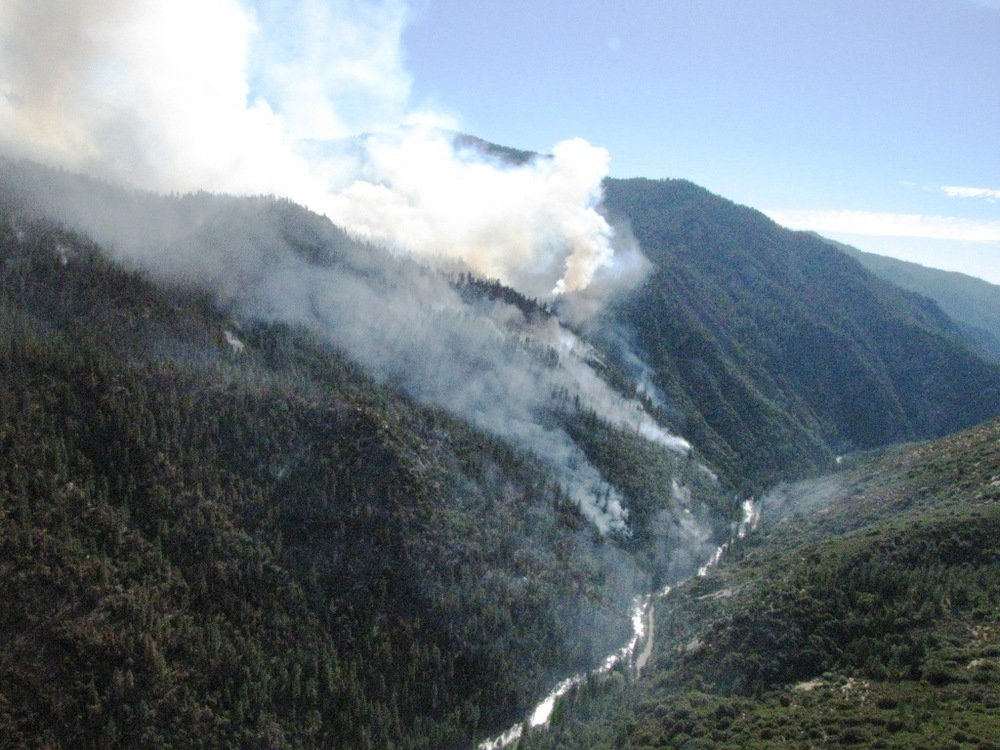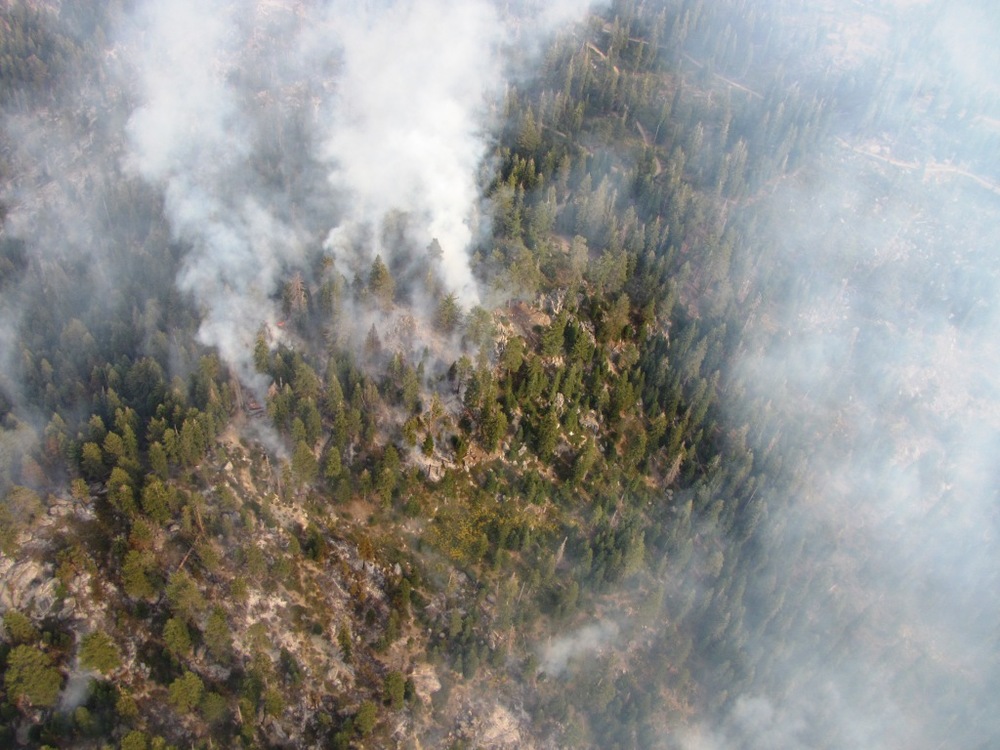A Burning Need: Landscape-scale Prescribed Fire
/by Eric Winford, Coordinator, California Fire Science Consortium - Sierra Nevada
The Sequoia National Forest isplanning to ignite one of the largest prescribed fires in California history – one unit, planned for fall 2014, will be 3,200 acres. The entire burn will eventually cover 14,300 acres over 5 years within the Boulder Creek watershed.
Larger prescribed fires are getting more attention because of the combination of ecological benefits and cost benefits. Most prescribed fires in California are 400 acres or less.[i] Annually, there is an average of 11,000 acres of prescribed fire for all the public lands in the Sierra Nevada.[ii]

A recent paper in the Journal of Forestry by Forest Service and University of California forest and fire experts calls for a fundamental change in the scale and objectives of fuels treatments to move areas out of fire suppression into fire maintenance. Scaling up the size of prescribed fire can reduce costs, increase ecological benefits, and provide for future maintenance through managed fire. Once treatments have brought the forest into a stand structure that is more resilient to wildfires, firesheds could have their future management converted to maintenance through managed wildfire.[iii]
The project is currently waiting for the right time to burn, though they had planned a burn in October 2013, the federal government shutdown limited their window of opportunity. The timing of this first segment is partly based on weather and partly based on the ability to seize an opportunity created by another fire 3 years earlier. Paul Leusch, Fuels Officer for Sequoia National Forest, expects the higher humidity and shorter days of fall to increase fuel moisture so the fire doesn’t burn too intense in the 3,200 acre burn. He’s also using the boundary of the 2010 Sheep Fire to control the perimeter of the fire as it moves down the watershed.
“It was a really nice light burn and it cleaned up the heavy fuels we had in the area,” says Leusch. “Once it was out, we said, wow, if it had gotten into Boulder Creek drainage we could have had 14,000 acres of additional resource benefit.”
The Sheep Fire was a lightning-started fire managed for nearly 3 months for the ecological benefits that the fire brought to the area. It ultimately burnt 9,020 acres through Kings Canyon National Park and Sequoia National Forest. These types of low-intensity fires make forests more resilient to more intense fires by removing small trees, brush, and fine fuels; they also help cycle nutrients and create wildlife habitat. Leusch hopes that after treating the area with prescribed fire, managed wildfire can be used to maintain the forest.
“We’re considering fire as a tool, “Leusch says. “It’s our hope to have a natural, unmanaged fire cycle and allow natural ignitions to occur.” Portions of the Boulder Creek watershed are in a wilderness area, so there are no roads and mechanical thinning operations are out of the question. “We don’t have road access so everything we need we have to take in by hand,” Leusch says. In such areas, managed fires – either through human ignition or lightning ignition – are often the only way to remove excessive fuels and restore the forest to a more resilient stand structure.
The vegetation in the Boulder Creek watershed changes from red fir at the top of the ridge to mixed-conifer around the middle to a shrub/oak mix at the bottom near the Kings River. It also has three giant sequoia groves – trees that need fire to help with seedling establishment. The historic fire frequency in these vegetation types varies on average from a 5 year cycle at lower elevations to a 45 year cycle at higher elevations.[iv] But with years of no fire in the area, there has been a build-up of fuels.
“This area hadn’t had fire in it for over 100 years and it was primed to go,” says Leusch. Building on the Sheep Fire helps Sequoia NF to increase the scale of prescribed fires. Small fires are fine if only there were enough of them, but funding and air quality – among other issues – limit the opportunity and the window when burns can occur. North et al. (2012) calculated that less than 20 percent of the forestland in the Sierra Nevada is receiving the fuels treatments (either through fire or mechanical treatment) needed to create and maintain historic fuel structures in the forest.[v] With the typical small scale project, there is simply not enough funding to do the necessary work. Cost is one hurdle solved by increasing the scale of the project.

“As the size of the acreage grows in the project the cost per acre drops significantly,” Leusch said. But even as costs per acre drop, air quality remains a concern. Smoke plumes from fires in the Sierra Nevada can hang around local towns and drift down into larger cities in the Central Valley, increasing the amount of particulate matter and ozone to unhealthy levels and creating haze that reduces visibility. The Rim Fire – which was an unmanaged wildfire – this summer near and in Yosemite National Park created unhealthy air quality conditions in towns as far away as Reno, NV, over 100 miles away.
During the two and a half years of the planning stages coordination and collaboration with partners like the San Joaquin Valley Air Pollution Control District, but also with non-profits like the Sierra Forest Legacy, became essential to the success of the project.
“It was definitely a collaborative effort,” Leusch says.
But the relationship does not end at the planning stage. For Trent Proctor, air quality program manager for the Pacific Southwest Region of the USDA Forest Service, communication and coordination with the air board, and monitoring of smoke emissions from the fire, are vital to the success of prescribed fires. The California Air Resources Board limits the days when burns can occur to days when air quality is already good and the weather helps move the smoke away from communities. Prescribed fires ignited in the fall and spring can take advantage of weather patterns that allow the smoke to disperse. The season of the burn and the fuel moisture are two components that help determine the windows when burns can occur. The fuel moisture, along with the outside temperature and humidity, helps determine how hot the fire will burn.
“There is a window in fall we have to hit,” Proctor says. The burn window is limited by high ozone levels in the summer and high amounts of particulate matter from residential stoves in the winter. In addition, more moisture in the winter increases fuel moisture to the point where the fire may not spread like they want. Managers want fuel moistures low enough that there will be sufficient combustion, but high enough so that the fire will not escape control.
Leusch knows there are likely to be pockets of higher intensity fire, but is using the topography to his advantage to keep the fire under control. “We’re starting at the top and letting it back down naturally over a period of days,” he said. “Fire doesn’t carry as well with short days and higher humidities.”
The mix of vegetation types in the watershed, the topography, and the size of the burn will allow for a variety of fire behavior – such as sporadic areas of high intensity – which can be good for wildlife and vegetation alike. According to the recent Forest Service Sierra Nevada “Science Synthesis”, prescribed fires that are variable in their intensity can create heterogeneous forest structures that are more similar to historic conditions (i.e., before European settlement). [vi] The use of prescribed fire over broad areas without restricting the area burned or the time the fire is allowed to burn can help restore the functionality of forests and provide the habitat variability scientists and managers are seeking.[vii]
The burn had been planned for earlier October of this year, but the federal government shutdown limited the burn window and they had to reschedule to fall 2014. Leusch and others plan to have a smaller 500-acre spring burn in another unit that will help to achieve resource goals.
References:
[i] California Department of Forestry and Fire Protection (CDFFP). 2012. Fire Perimeters Version 12_1. GIS Database, downloaded from: http://frap.fire.ca.gov/data/frapgisdata-sw-fireperimeters_download.php.
[ii] North, M., Collins, B., Stephens, S. 2012. Using Fire to Increase the Scale, Benefits, and Future Maintenance of Fuels Treatments. Journal of Forestry 110(7):392-401.
[iii] North, Malcolm, ed. 2012. Managing Sierra Nevada forests. Gen. Tech. Rep. PSW-GTR-237. Albany, CA: U.S. Department of Agriculture, Forest Service, Pacific Southwest Research Station. 184 p.
[iv] North, M., Collins, B., Stephens, S. 2012. Using Fire to Increase the Scale, Benefits, and Future Maintenance of Fuels Treatments. Journal of Forestry 110(7):392-401.
[v] Ibid.
[vi] Collins, B. and Skinner, C. 2013. Fire and Fuels. Chapter 4.1 in Science synthesis to promote resilience of social-ecological systems in the Sierra Nevada and southern Cascades. USDA Forest Service Pacific Southwest Research Station.
[vii] North, M. 2013. Forest Ecology. Chapter 2 in Science synthesis to promote resilience of social-ecological systems in the Sierra Nevada and southern Cascades. USDA Forest Service Pacific Southwest Research Station.



